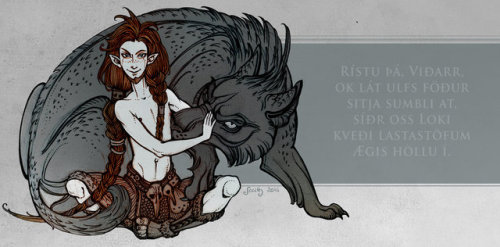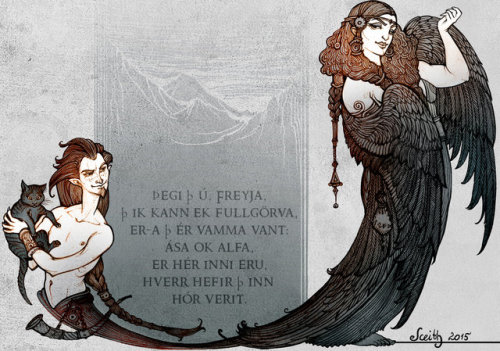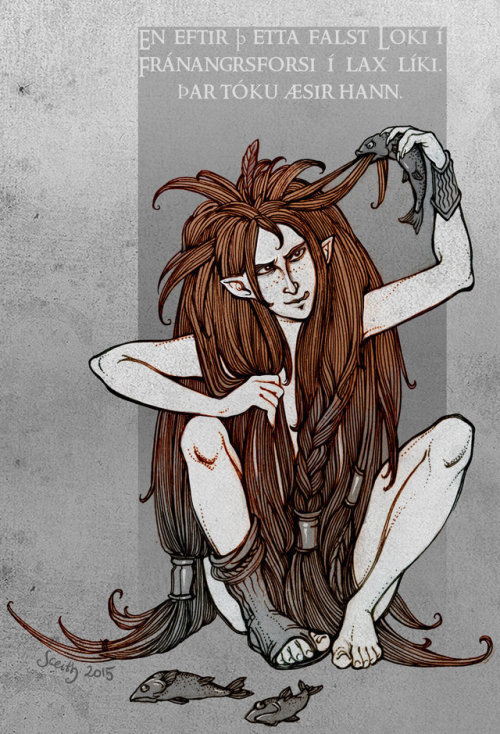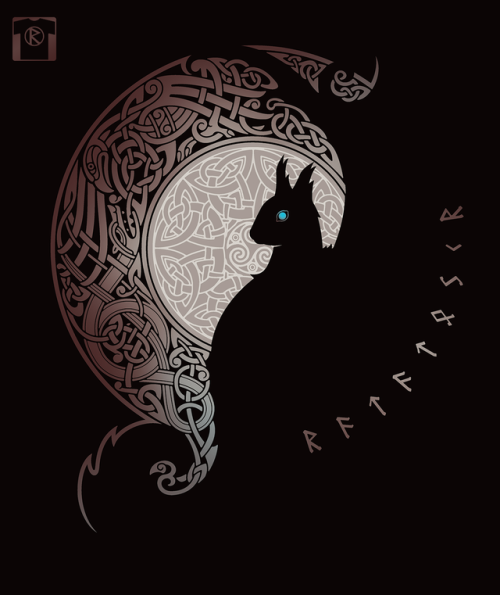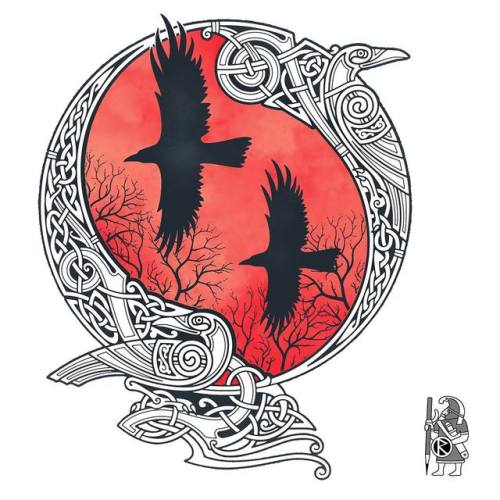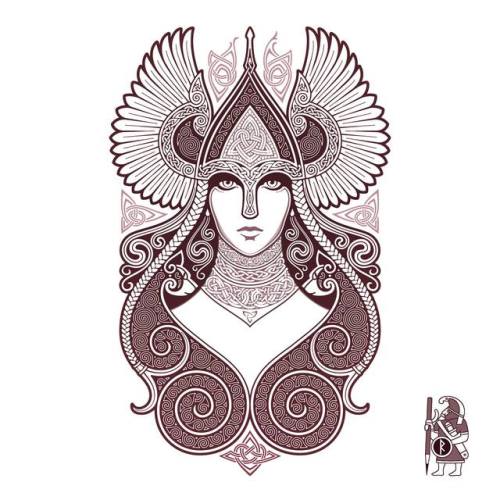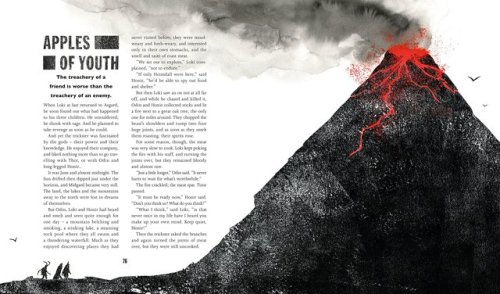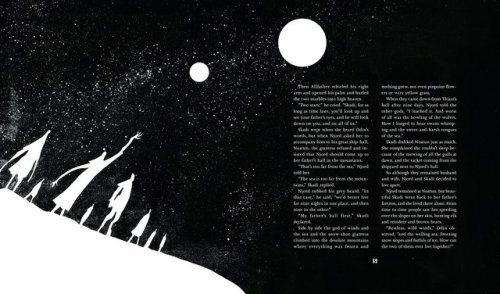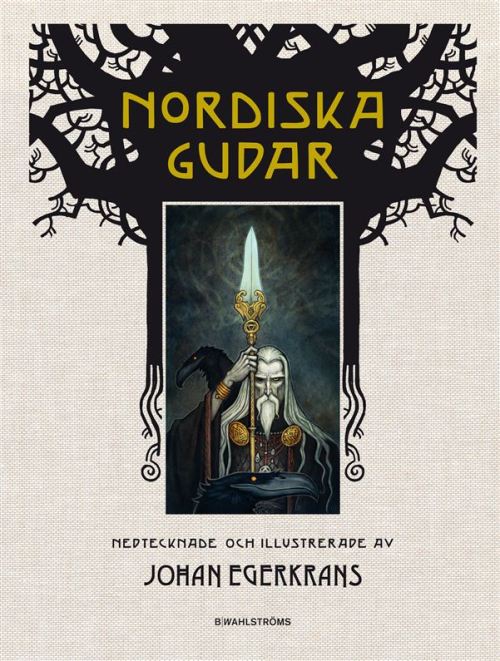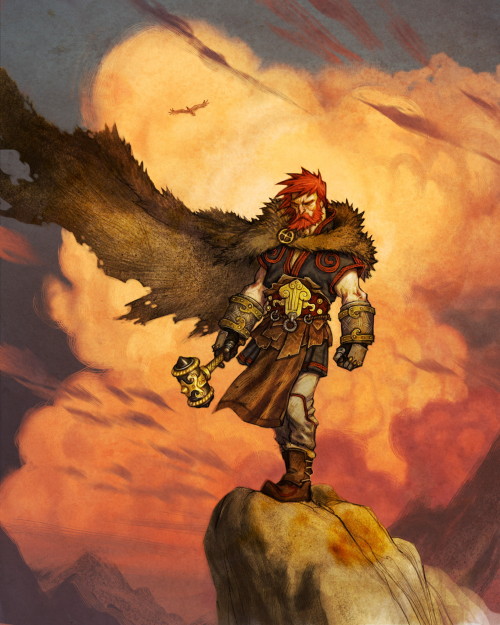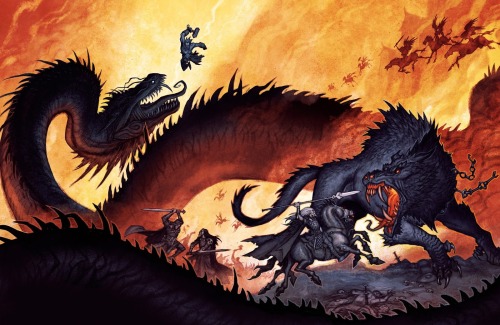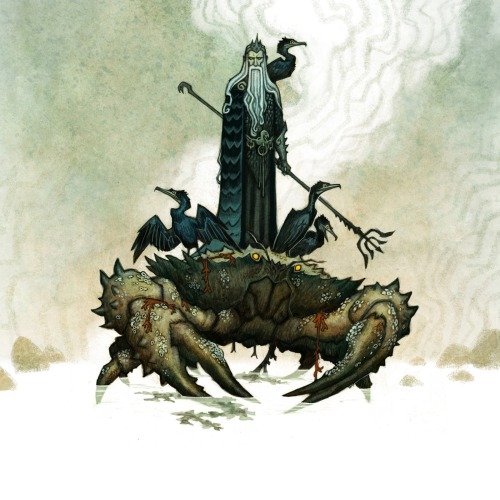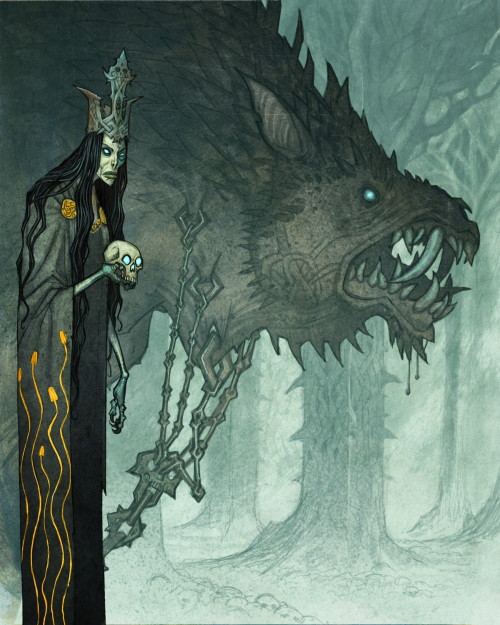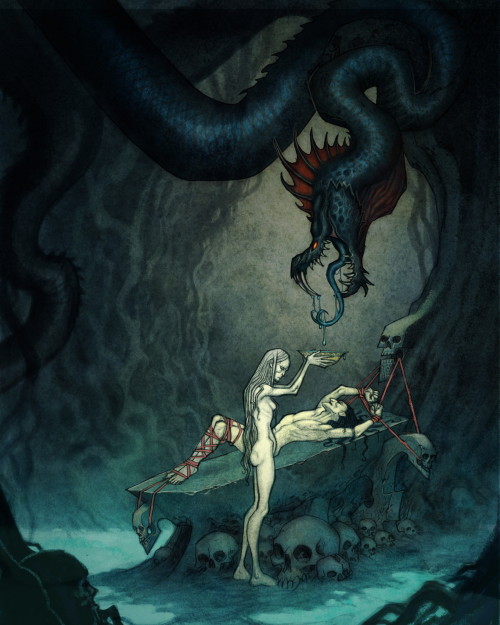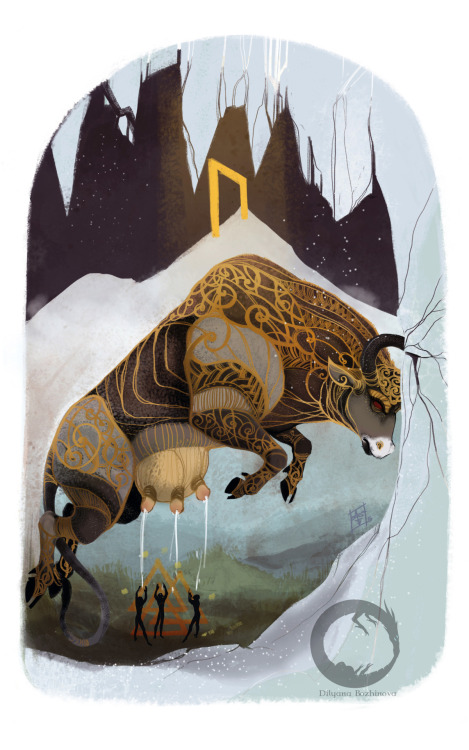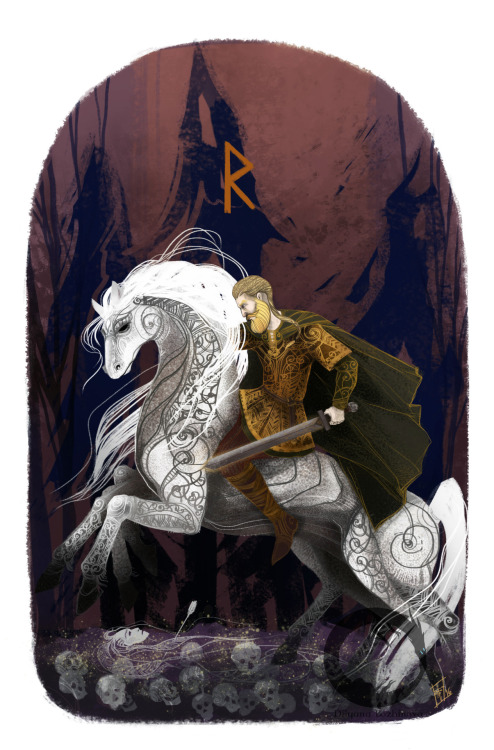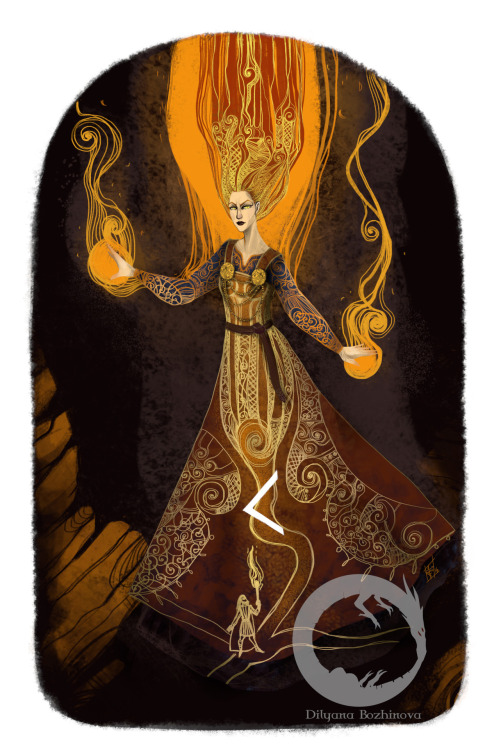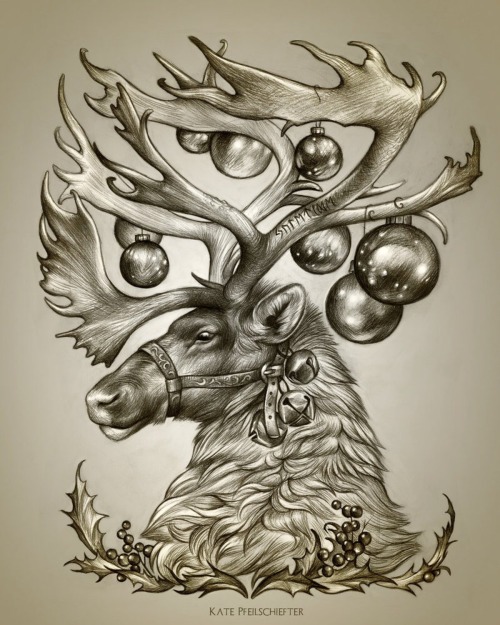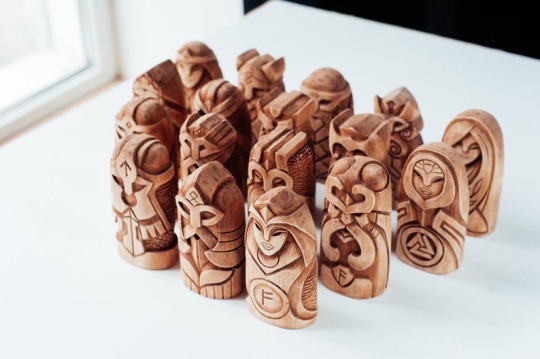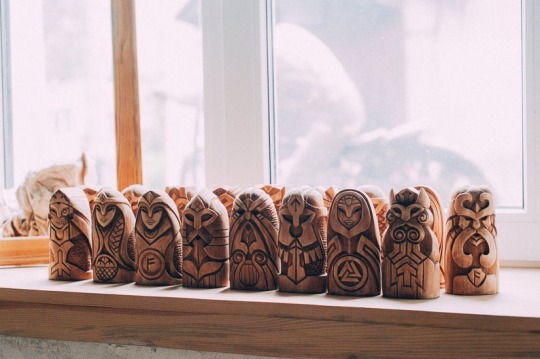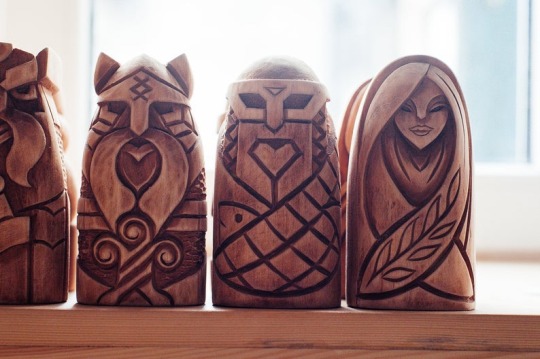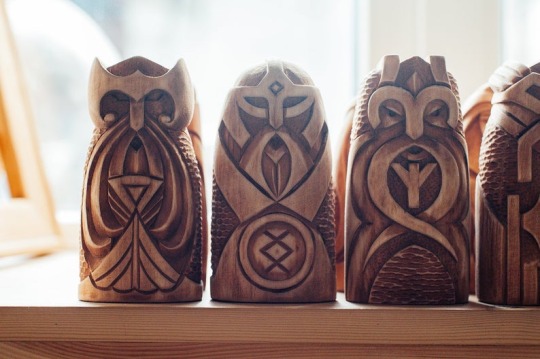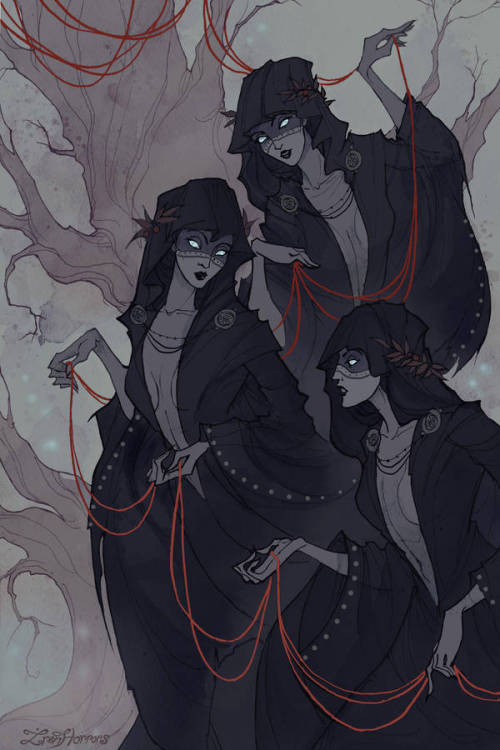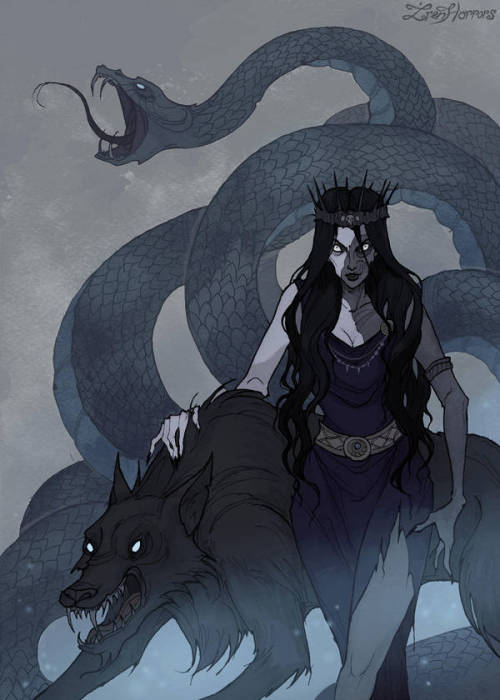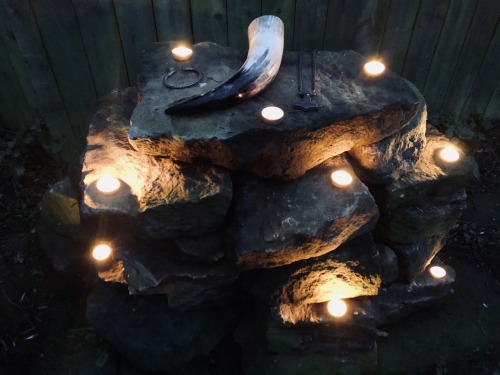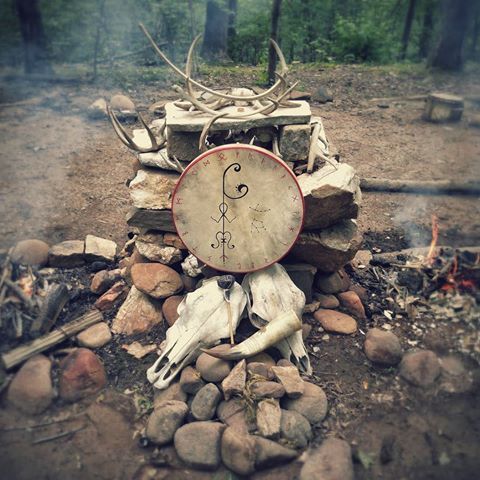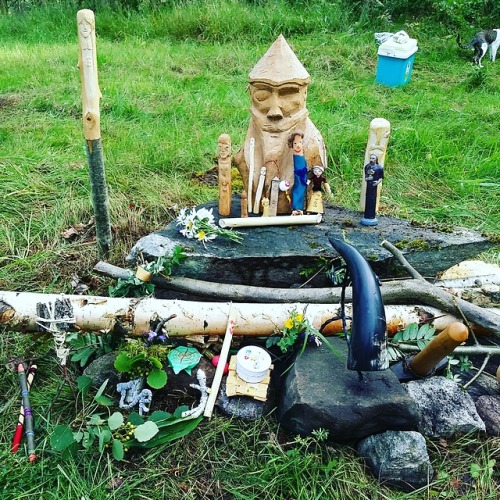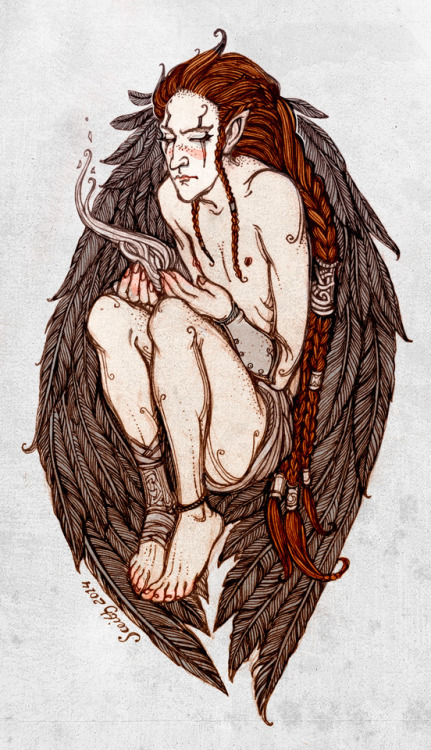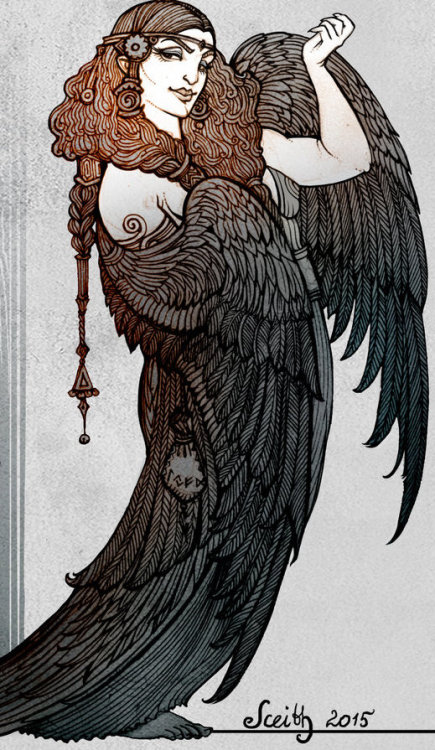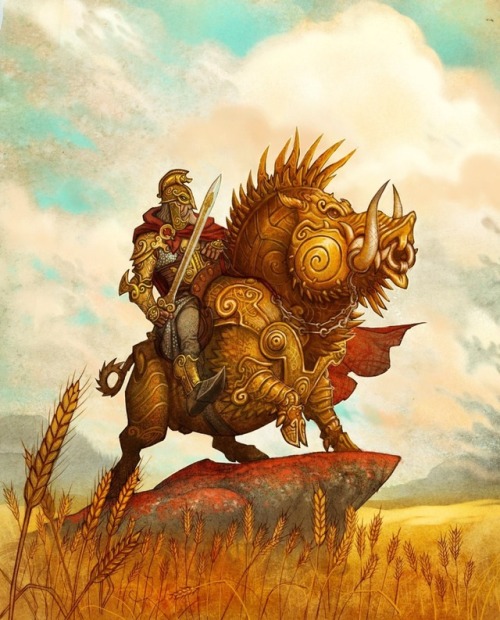#åsatro
It has been a while since I have featured more from Sceith-A but it is always a pleasure to showcase her stunning artwork.
From top to bottom:
Sif
“Alone thou wert,
if truly thou wouldst,
All men so shyly shun;
But one do I know, full well, methinks,
Who had thee from Hlorrithi’s arms,
(Loki the crafty in lies.)”
Wolf’s Father
“Stand forth then, Vithar,
and let the wolf’s father,
Find a seat at our feast;
Lest evil should Loki speak aloud,
Here within Ægir’s hall.”
Freyja
“Be silent, Freyja!
for fully I know thee,
Sinless thou art not thyself;
Of the gods and elves
who are gathered here,
Each one as thy lover has lain.”
Skadi
Loki
“And after that Loki hid himself in
Franang’s waterfall in the guise of a salmon,
and there the gods took him.”
Post link
Heathen blot ceremony filmed in Norway, 2012.
Oskoreia
In Scandinavia, Oskoreia (also called Åsgårdsreia, Julereia or Odens Jakt in other regions) meaning “Asgard Riders” is the modern folk belief related to Christmas that traces its roots back to the Old Norse tradition commonly known as The Wild Hunt.
Oskoreia is a Yuletide tradition viewed as a phantasmagoria of dream-like images of hunters (usually led by Odin) and hunted engaging in battle, typically signalled by the howling of Odin’s wolves, always one louder and the other quieter. The group of riders may be alive or dead, real humans or deities, insignificant or noble, male or female and with many regional variations.
It is said to have foretold changing weather in many regions but it could also mean imminent war and unrest. According to some reports, the forest turned silent and only a whining sound along with dog/wolf barking could be heard.
The pursuit can span across the sky but it is said that the hunt may never get closer to the ground than an “ox can wear its yoke”. If caught in the path of Oskoreia it is believed that a person may be swept up into the mayhem and so a good strategy to keep safe is to jump to the ground, thus making oneself lower than the height of an ox’s yoke and allowing the hunt to pass above.
In some regions, folk wisdom advised that people should carry some iron/steel and some bread with them as they walked during the Yule season in case they might encounter Oskoreia. If one should find themselves face to face with Odin, then they should throw down the iron/steel in front of them to ward off trouble. Further, if the person should meet his wolves then they should throw the bread, which they will eat instead of the person.
Another tradition stemming from Oskoreia is the “Christmas goat walk” (”Gå julebukk” in Norwegian) in which masked and costumed people (now usually children) go from door-to-door, singing carols for rewards of sweets.
Artwork by HeySpace
Post link
NORDISKA GUDAR (NORSE GODS)
Johan Egerkrans (the Swedish artist who created Nordiska Väsen) has recently released his newest book entitled Nordiska Gudar (meaning “Norse Gods”) and it is exceptional! Please enjoy some of the artwork from within.
Post link
Hræsvelgr
“Hræsvelgr he is called,
who at the end of heaven sits,
a Jötun in an eagle´s plumage:
from his wings comes,
it is said, the wind,
that over all men passes.”
- Vafþrúðnismál
Photograph by Grete Øiamo
Post link




Kulturhistorisk museum in Oslo hosted an exhibit named “Fabulous Animals”, exploring the connection between humans and animals in the period from the Iron Age to the Viking Age, through archaeological finds.






I hope you will enjoy some photographs of some of the exhibits.
Til års og fred
“Heathenism is, that men worship idols; that is, that they worship heathen gods, and the sun or the moon, fire or rivers, water-wells or stones, or forest trees of any kind; or love witchcraft, or promote ‘morth’-work in any wise; or by ‘blot,’ or by ‘fyrht;’ or perform any thing pertaining to such illusions.”
This excerpt from The Law Codes Of King Cnut, written by Archbishop Wulfstan (on behalf of King Cnut) in approximately 1020, serves as a fantastic outline for exactly what constituted “heathen” practices, from the time at which they were trying to ban such practices.
Thorpe Translation, Winchester Laws Volume 1, p.162

Whispers Of Yggdrasil
Robin Hoods Bay, England (5/2/21)
St. Olav - An Echo Of Thor?
A red bearded warrior, hunting trolls with his axe on his travels does not require us to make a huge leap of imagination in order to note similarities with the norse god Thor. However, there is far more to the comparison that St. Olav may have been used to reimagine pre-Christian beliefs surrounding Thor if we look a little deeper…
Following Christianisation in Northern Europe, many Scandinavians kept their heathen beliefs alive through syncretism with Christianity. A strong case can be made for this practice being evident with the Catholic saint and former king of Norway, Olav Haraldsson, celebrated each year on 29th July.
In Scandinavia, from long ago through until more recent times, St. Olav’s day was the day when the people would pray for thunder (named directly from Thor) and (as they referred to it) “the rain of the Æser” to prepare the crop for harvest, which they so eagerly awaited to come to fruition at this time of year.
St. Olav, like Thor, could control trolls and giants, according to legend. When he travelled around Norway on his Christening mission, the trolls often tried to block the way for him. He then used his power to turn them to stone, as if he was the sun, using a cross instead of Thor’s hammer, mjølner
One story, from the area of Ringerike, tells us that when St. Olav tried to pass a place called Krokkleiva, an angry giantess jumped out of the mountainside and said:
“Saint Olaf with the red beard, you are riding too close to my cellar wall!”
But St. Olaf replied:
“Stand you there in wood and stone until I return!”
Whereupon the giantess was turned into stone.
Similar stories are told about various landscape features throughout Norway. People also saw other traces of St. Olaf in the landscape, such as footprints of his horse. A stone in Setesdal is said to be his chair, two rocks near Stiklestad are his bowl and cup, etc…
Another famous landmark is The Well Of St. Olav at Karmøy:
“The legend claims that King Olaf was followed by enemies through the strait Karmsund. He sailed his ship to the western side of the island. From here the King and his men started to drag the ship over land from Torvastad to Vikingstad.The hard work made them thirsty and the King stabbed his clenched fist in the rock. Immediately it came roaring up clear water so everyone could drink.”
Most interesting about St. Olav’s Well is that it is located in Torvastad and just a few hundred meters to the west we find Hovland. As the name suggests, it was likely to have been a pagan hov (temple). We know that water played a major role in Norse mythology, and perhaps the water in St. Olav’s well also had a sacred function in Pre-Christian times.
In Viking times, before the conversion to Christianity (and after it, too), people in Norway believed in different supernatural beings living in the landscape. Landscape features could also be made by them, such as mountains being petrified trolls, or a ravine being the axe blow of a giant. With these stories about St. Olav, this way of thinking and explaining the landscape takes on a Christian mask, yet it is still fundamentally a continuation of traditional beliefs.
Post link


Hil Njord!
Hil Æge!
Hil Rån!
Hil ni døtre av hav!
Pictures are my own (see if you can match my stone pile)
Sommersolverv
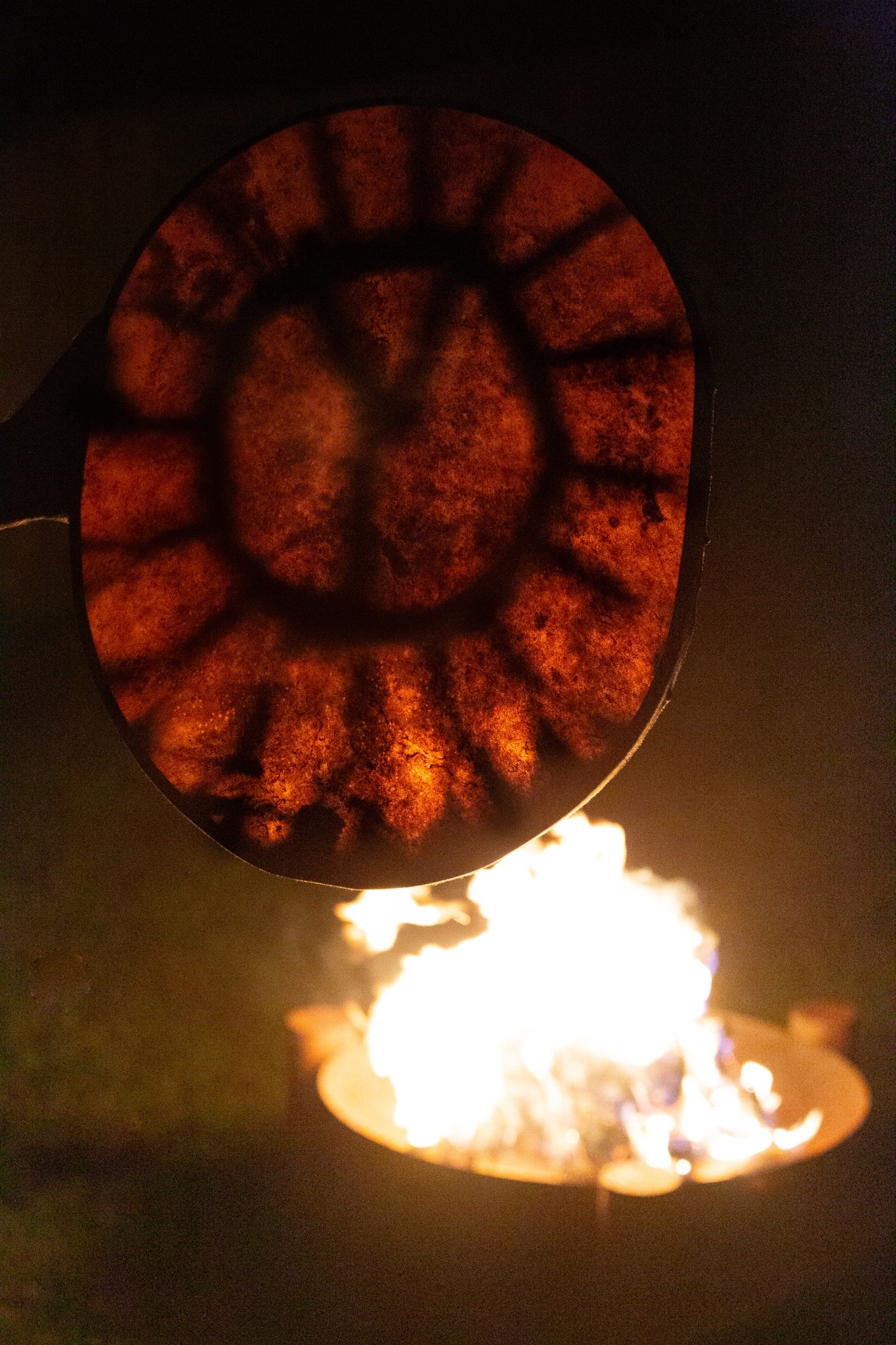
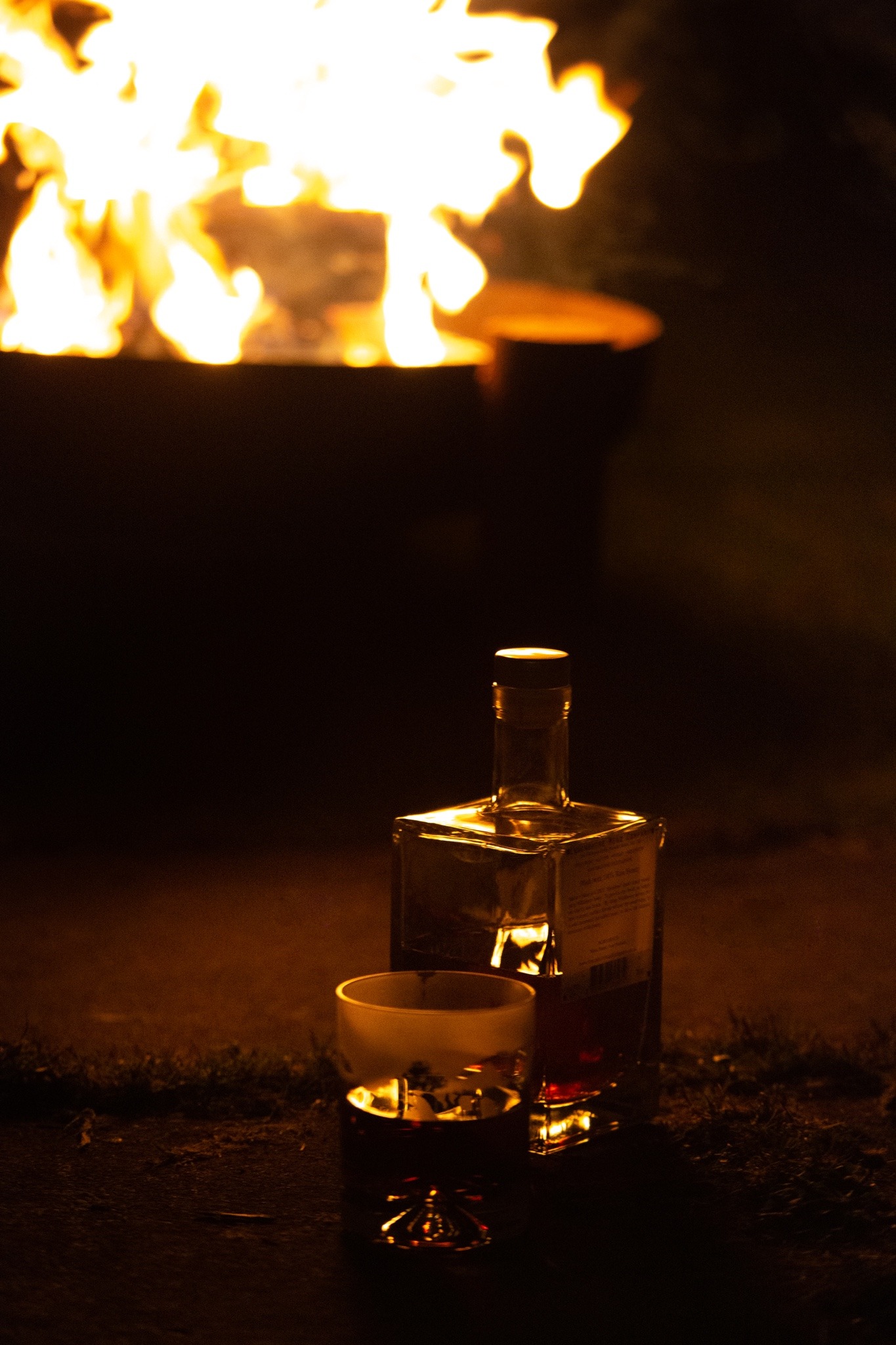

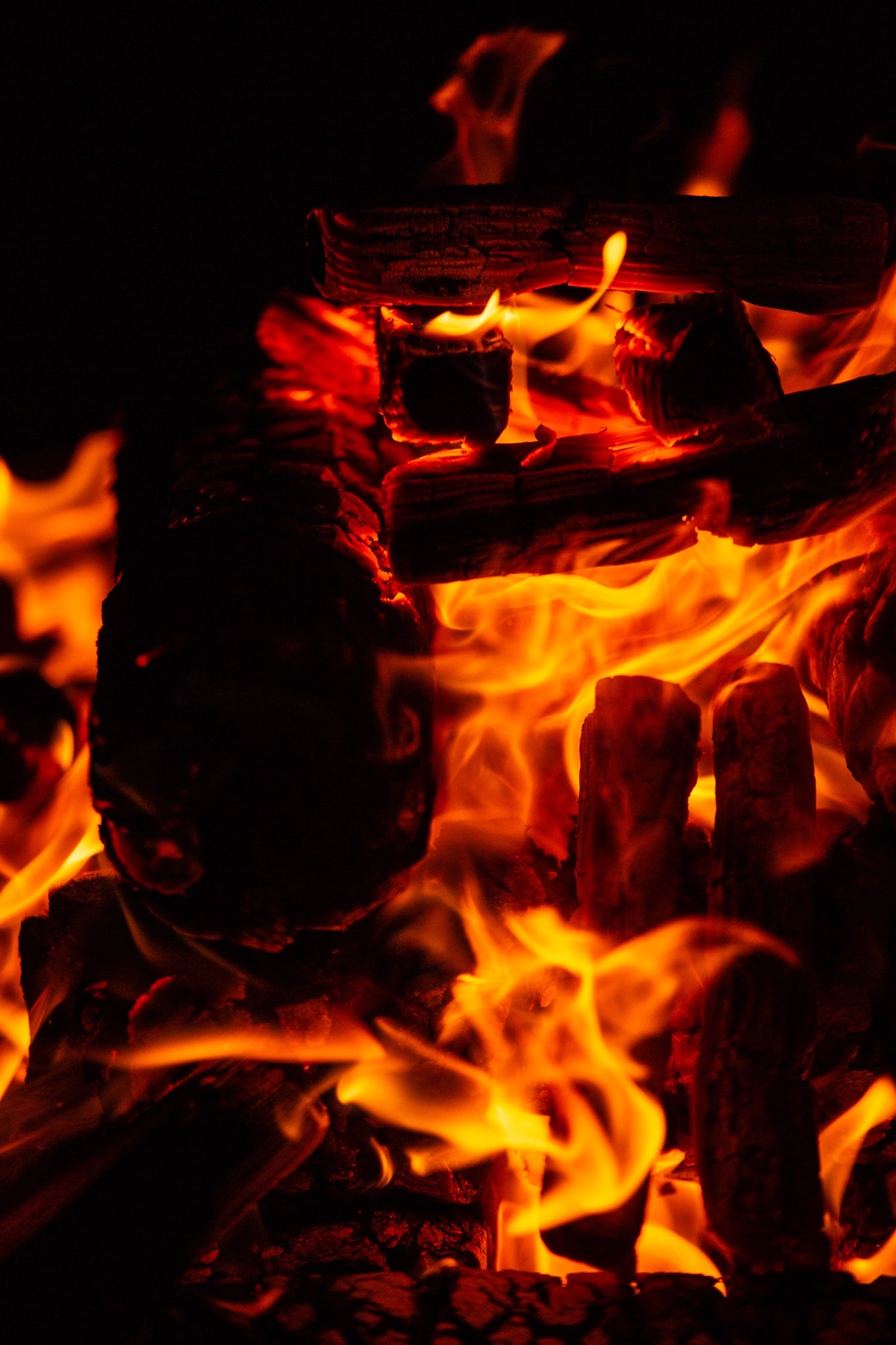

The longest day, the shortest night,
Natt is in absence,
The shortest darkness, the longest light,
Dag rules this sky,
Sol enlightens a world more bright,
Just as the embers of the midsommar fire,
Until the sun rises, they must stay alight,
Make haste, the days move quickly now,
Jord grows stronger now,
And Balder’s brightness shining through,
As Hod stirs from his deepest sleep,
Anticipating the falling leaves,
For one more year, give thanks,
Sol ascends tonight.
Images and poem by @hedendom
Thunderstones

A Scandinavian/Nordic folk belief pre-dating the Viking Age, a tordenstein (in Norwegian), known as a ‘thunderstone’ in English and ‘dynestein’ in Old Norse, refer to recovered Stone Age flint axes/tools (usually dug up from the earth after many years beneath the surface) used as talismans, protective amulets and sacred objects in heathenry.
Believed to have been hurled to earth by Thor, within lightning bolts during thunderstorms, as weapons to destroy trolls, alver (elves) and other malevolent vetter (mystical or spirit creatures), to protect the world from chaotic forces.
This ancient tradition is one of the longest continuously running and most widely spread customs in human history, practiced for many thousands of years across many cultures, in various different ways.

When thunderstones were first excavated from Viking Age graves, they were initially dismissed as accidental additions because they were dated as much as 5000 years before the burial. As more evidence emerged and more examples were excavated (including one in an untouched, sealed stone coffin), it was soon understood that these thunderstones held significant importance. Some unearthed examples were even carried to Iceland all the way from Norway by treacherous sea voyage! It is believed that they protected houses and people, along with protecting the hamingja (”luck”).


To the Vikings, there were three essential properties for a thunderstone, according to Olle Hemdorff, an archeologist from the University Of Stavanger, Norway and expert on the topic:
“The form had to be similar to an ax or a hammer—that is, a ground stone or flint. The stone had to have ‘flaming’ properties, which flint and quartz have. And all the stones were damaged with the edge chipped off—'proof’ that they fell from the sky.”
In Scandinavian folklore, thunderstones are seen as potent magical artefacts and anyone lucky enough to dig one up possesses a very powerful charm. Often worshipped as famial or ancestral deities/powers, they are said to protect against spells and witchcraft, if kept on the person.
Similarly, if placed within the wall of a home, they will bring good luck, prevent lightning from striking and protect against bad magic.
When used within a sacrificial blot ceremony, the thunderstone would be venerated with an offering of beer, poured over the stone, or anointed with butter.
Photographs:
- My own tordenstein.
- Lightning shower (CNN, 2014).
- Artistic recreation of Viking Age woman with tordenstein in excavated in Kongshaugen, Norway.
- Photograph of the Stone Age greenstone axehead and grave goods found buried with the Viking Age woman (as above)
Vinternettene - Winternights
October 14th
It is customary that every year at sundown on 14th October, heathens will celebrate vinternettene (winternights), also known as høstblot (autumn blot), vinterdag (winter day) or vinternatt (winter night).
14th October was the day that Scandinavians would turn over their primstav to mark the beginning of the winter half of the year and welcome the cold weather returning, a tradition that pre-dates Christianity in Scandinavia. Marked with the symbol of a mitten (as it was customary to knit new mittens for the coming cold weather), it is also said that the weather on vinternettene will be a signal of the weather for the coming winter.
The sacrificial blot accompanying this was usually dedicated to Frøy (Freyr), alver (elves) and the diser (disir). Asking that Frøy will return swiftly to sow the seeds of rebirth and that we make it safely through the coming cold and snow.
Til års og fred!
Post link
Ksenia Svincova has created some dark and fantastical artwork inspired by Norse Mythology.
Featured here:
The Norns
Freyja
Idunn
Loki
Loki’s Children
The Wild Hunt
Skadi
The Punishment Of Loki
Post link
Horg
“þeir er hǫrg ok hof hátimbroðo”
“Shrines and temples they timbered high”
- Völuspá
A horg (Old Norse “hǫrgr”) is a sacrificial site or a form of altar in pre-Christian times in the Nordic countries and which roughly refers to a "stone pile".
In the poem Hyndluljóð, the goddess Frøya (Freyja) speaks favorably of Ottar (Óttar) for having worshiped her so faithfully by using a horg. Frøya details that the horg is constructed of a heap of stones and that Ottar often reddened these stones with sacrificial blood in dedication to her. Snorre Sturlason states that the horg is used in the veneration of the Åsynjene (female gods).
In the poem Vafþrúðnismál, it is also stated that many a horg and hov were dedicated to Njord (Njörðr).
A horg is considered different to a hov (from the Old Norse hof), commonly called a “temple”. A rough simplification is that horg were for outdoor rituals and hov for indoors worship.
Many modern day heathens within Scandinavia continue to use a stone set as a focal point for rituals conducted outdoors to this day.
Post link
Fjaðrhamr
In Norse Mythology (and indeed also modern folk belief), the way in which humanoids can posses wings, fly or literally transform to a bird is to undergo a feathered transformation known as Fjærham/Fjederham (in modern Scandinavian tongue) or Fjaðrhamr (in Old Norse).
Fjær/fjeder/fjaðr means “feather” and ham/hamr means the form or shape. So it literally translates as “feather-form”.
The most prominent examples of “feather-form” are Freya’s feather cloak, which is used by Loki in Þrymskviða, the Norns who are said to transform into swans to travel midgard and the hero, Germand Gladensvend, from the Danish folk ballad of the same name.
Art:Sceith-A
Post link
Vintersolverv
The shortest day, the longest night,
Sol is in absence,
The longest moon, the shortest light,
Måne rules this sky,
Darkness envelops a world less bright,
Just as the embers of the midwinter fire,
Until the sun rises, they must stay alight,
The knowledge that days grow longer now,
Hope grows stronger now,
And warmth supports survival,
As Frøy returns on his golden steed,
To sow the seed of life,
For one more year, give thanks,
Sol is reborn.
Poem:@hedendom
Artwork: Johan Egerkrans
Post link
Having seen various incorrect, incomplete and inaccurate lists of Norse gods circulating Tumblr, I have decided to write my own and also include common terminology alongside. I will also include other beings who exist within the old lore and modern traditions.
I have opted to include the names in Norwegian, with translations in parenthesise after, along with a brief summary of some of the associations given to some of those gods. Be aware that, as an overview, brevity is necessary here and the individuals should not be oversimplified to basic aspects in your practice!
Æser (Æsir, Male Gods)
- Balder (Baldr, Baldur) - Light, purity, rebirth
- Brage (Bragi) - Poetry, eloquence, wisdom and music
- Delling (Dellingr) - The new day, dawn
- Forsete (Forseti) - Justice and reconciliation
- Frøy (Freyr) - Vaner, virility, fertility, the sacred religious position of royalty, prosperity, good weather and sunshine
- Heimdall (Heimdallr) - The senses, premonition or foreknowledge
- Hermod (Hermóðr) - Bravery, spirit, possibly a former mortal hero/king elevated to the Æsir
- Hjuke (Hjúki) - Man, lunar activity, lunar phases, moon craters, brother of Bil (the Scandinavian children in the moon)
- Hod(Höðr, Hodr) - The blind god, darkness, rebirth, second chances
- Høne (Hænir, Hœnir) - Survival, sense/spirit, beauty,
- Lodur(Lóðurr) - Blood, warmth, life,
- Loke (Loki) - Change, creativity, ambiguity, impulsiveness
- Lyter (Lýtir) - Premonition, foresight, prediction, prophecy
- Magne (Magni) - Strength, development, son of Tor
- Meile - Son of Odin, brother of Tor
- Mime(Mímir) - Wisdom, knowledge, memory, advice
- Måne (Máni) - The moon, the night sky
- Njord (Njörðr) - Vaner, the sea, harbours, ports, seafaring, wind, fishing, wealth/prosperity, and crop fertility
- Od (Óðr) - Madness, fury, eagerness, excitement
- Odin (Óðinn) - Father, war, battle, victory, death, wisdom, runes, magic, poetry, charms
- Tor (Þórr, Thor) - Thunder, lightning, storms, rain, strength, protection, hallowing, healing, fertility
- Ty (Týr, Tyr) - Law, sacrifice, heroism, glory, war
- Ull (Ullr) - Skiing, archery, hunting, weapons, shields, personal combat, oaths
- Vidar (Víðarr) - Vengeance, atonement, preparation, survival, silence
- Vilje (Vili) - Will, willpower, moderation, the middle, wit, intelligence, touch, sense, motion
- Ve (Vé) - Countenance, appearance, facial expression, speech, hearing, sight
- Våle (Váli) - Revenge, bravery, daring, marksmanship, survival, rebirth
Åsynjer (Ásynjur, Female Gods)
- Bil - Woman, lunar activity, phases of the moon, sister of Hjuke (the Scandinavian children in the moon)
- Eir - Help, healing, protection, mercy, grace, calm
- Fjorgyn/Jord (Fjörgyn/Jörð) - Earth, the world, nature, greenery
- Frigg - Mother, love, fate, prophecy, marriage, birth, midwifery
- Frøya (Freyja) - Vaner, fertility, love, passion, sex, sexuality, beauty, fertility, gold, magic, war, death
- Fulla - domesticity, cleaning, housekeeping, listening, confidant, secrecy
- Gersemi - Precious, beauty, blonde hair
- Gjevjon (Gefjun) - Virginity, plowing, female independence
- Gnå (Gná) - Messenger, errands, crossing planes of existence, travel through land, air and water
- Hnoss - Treasure, beauty, brunette hair
- Idunn (Iðunn) - Youth, vigour, apples, love
- Ilm - Fragrance, aroma, smells
- Irpa - Guardian goddess, Hålogaland
- Lin (Hlín) - Weddings, domestic sphere, flax, onion, fabrics
- Lovn (Lofn) - Benevolence, kindness, gentleness, consolation
- Nanna - Loyalty, empathy
- Njorun - Soil, the land
- Rind (Rindr) - Princess/goddess/giantess, mother of Våle from the East
- Rån (Rán) - Sea, protection from drowning, fishing
- Sigyn - Loyalty, burden, sadness
- Siv (Sif) - Fields, wheat, fertility, family, wedlock
- Sjavn (Sjöfn) - Love, sex, desire
- Snotra - Wisdom, intelligence, cleverness, appropriate conduct
- Sol (Sól) - The sun, warmth, daylight
- Syn - Refusal, denial, speaking out, legal defence
- Såga (Sága) - Seeress, all-seeing, companionship, drinking partner
- Torgerd Hølgebrud (ÞorgerðrHolgabrúðr) - Guardian goddess, Hålogaland, heathen shrines
- Var (Vör) - Honesty, awareness, caution, carefulness
- Vår(Vár) - Oaths (and punishing oath breakers), pledges, agreements, betrothal
Jotner (Jötnar, Elemental Giants)
- Aurvandil - Star, planet, Orion & Big Dipper constellations
- Bauge (Baugi) - Farmer, money, wages
- Dag (Dagr) - Day, light, rides Skinfakse
- Fornjot (Fornjótr) - Ancient giant, ancestor, original, owner
- Frosti (Jökull) - Cold, winter, frost, ice, icicles, glaciers
- Fårbaute (Fárbauti) - Hitting, striking, cruelty, danger, violence
- Geirrød (Geirröd) - Entrapment, cruelty, aggression, violence
- Gyme - Hills, Mounds
- Helblinde (Helblindi) - “Hel Blinder”, “All Blind”
- Hyme (Hymir) - Brewing, cauldron, thick skull
- Kåre (Kári) - Wind, scathe, howl, sails
- Loke (Loki) - Change, creativity, ambiguity, impulsiveness
- Loge (Logi) - Fire, wildfire,
- Mime (Mímir) - Knowledge, wisdom, memory, counsel, Mimes Brønn (Mímisbrunnr)
- Mokkurkalve - Clay, life, innocence, childishness
- Norve (Narfi) - Narrow, oppressive, closed in, difficult birth
- Rungne (Hrungnir) - Strength, brawling, fighting, whetstone
- Snø (Snær) - Snow
- Surt (Surtr) - Fire, heat, burning, blackness
- Suttung (Suttungr) - Mead of poetry, orphaned, eagle
- Tjaste (Þjazi, Thiazi) - Abduction of Idunn
- Torre (Þorri, Thorri) - Black ice, frost, cold, winter
- Trym (Þrymr, Thrymr) - Uproar, King of Jotner,
- Vale (Vali) - Unlucky, wolf, murdered his brother Norve
- Vavtrudne (Vafþrúðnir) - Riddles, weaver of tales
- Utgards-Loke (Útgarða-Loki) - The outer places, magic, illusion, beyond society, an alternate plane
- Yme (Ymir) - The big bang, primordial, birth, the ancestor of all, elemental
- Æge (Ægir) - Sea, ocean, sea creatures, protector of sailors
Gygrer (Gýgr, Elemental Giantess)
- Angerboda (Angrboða) - Grief bringer, sorrow, Iron Wood
- Aurboda ( Aurboða) - Gravel, mountains
- Bestla - Mother to Odin, Vilje and Ve.
- Driva (Drífa) - Snowfall
- Fonn - Snowdrift
- Gerd (Gerðr) - Beauty, light, fertility, earth
- Grid (Gríðr) - Greed, vehemence, violence, impetuosity
- Hel - Death, Helheim (the underworld), Náströnd (“Corpse Shore”)
- Hyrrokkin - Fire smoked, smoke, strength, wolves, serpents
- Jernsaksa (Járnsaxa) - Iron knife, mother to Magne
- Lauvøy (Laufey) - Needle, slender, weak
- Menglød (Menglöð) - Lives in a castle guarded by Fjölsviðr
- Mjoll (Mjöll) - Powdered snow
- Natt (Nótt) - Night, darkness, nightfall, counting time, rides Rimfakse
- Skade (Skaði) - Damage, archery, hunting, skiing, winter, mountains
Vetter (Vættir, Beings) & Other
- Alver (Elves) - Light/Dark/Black, personification of nature
- Andvare (Andvari) - Dwarf, “careful one”, waterfall, fish, wealth, magic ring called Andvaranaut
- Ask og Embla - The first humans, ancestors of humanity
- Diser (Dísir) - Female protective deities/spirits, fate
- Dverger (Dvergar) - Dwarfs, metallurgy, wisdom, smithing, mining, crafting
- Einherjer (Einherjar) - Honoured dead, fallen in battle, sent to Folkvang or Valhalla
- Fenrisulven (Fenrisúlfr) - Death, destruction, rage, the end of times, fen-dweller
- Fjolne (Fjölnir) - Swedish king, Vaner, son of Frøy and Gerd
- Gullveig/Heid (Heiðr) - Volva, seid, enigmatic, “Lust For Gold” or “Golden Drink”
- Kvase (Kvasir) - Wisdom, knowledge, skaldship, poetry, mead, blood, juice
- Midgardsormen (Jörmungandr, Midgard Serpent) - Sea serpent, poison, self-reflexivity, cyclicality
- Norner (Norns) - Weavers of fate, Wyrd, destiny, birth, death
- Sigurd Fåvnesbane - Stag, hero, wisdom, prophecy, speak to birds
- Starkad (Starkaðr) - Jotun, hero, great warrior, many arms cut off by Tor
- Troll - Isolated natural landmarks, strength, slow, dim witted,
- Valkyrjer (Valkyries) - Choosers of the slain, Odin’s maids, spirits, ferocity, death, ravens, wolves
- Vanlande (Vanlandi) - Hero, Swedish king, Vaner, “Man from the land of the Vaner”,
- Vedfinn (Viðfinnr) - Father of Hjuke and Bil
- Vetter (Vættir) - landvette, skogsvette, husvette, vannvette, sjøvette, havvette, hulder, nøkken, draugen, nisse, troll, huldrefolk, deildegasten, dradokke, trollkatt, basilisk, krake, utburd, lyktemenn, varulv, marmæl, lindorm
- Volund (Völundr) - Blacksmith, magical powers, sword maker, hero, alvedrotten (Chieftan of elves)
Well this became popular.
Tusen takk! Many thanks!
I appreciate all of the kind comments and notes.


